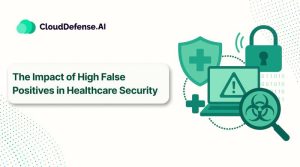What Is Vulnerability Remediation? — Definition
Before diving into vulnerability remediation, it’s important to understand what a vulnerability is in the context of cybersecurity.
In the context of cybersecurity, a vulnerability is a weakness in a computer system, application, or network that can be exploited by attackers to gain unauthorized access, steal data, disrupt operations, or deliver malware. These vulnerabilities can stem from various sources:
- Coding errors: Mistakes made during the software development process can create vulnerabilities.
- Design flaws: Even well-intended design choices might introduce unforeseen weaknesses.
- Misconfigurations: Improper system or software settings can leave gaps in security.
- Outdated software: Unpatched software with known vulnerabilities becomes easy prey for attackers.
Now, vulnerability remediation is all about finding and fixing security weaknesses in your systems before attackers can exploit them. It’s a proactive approach to keeping your digital assets safe and reducing the chances of a breach.
Here’s What It Involves:
- Finding Weak Spots: Regularly scanning your systems to uncover security gaps or misconfigurations.
- Fixing the Issues: Applying patches, updates, or changes to close any security loopholes.
- Minimizing Risk: Putting security measures in place for vulnerabilities that can’t be fully resolved.
- Staying Alert: Continuously monitoring for new threats and vulnerabilities as they emerge.
- Meeting Regulations: Ensuring your systems comply with industry regulations and best practices.
In short, vulnerability remediation helps you stay ahead of potential threats, making your systems more resilient and your data more secure. It’s about taking action before problems escalate.
| Read More: Confused about cybersecurity terms? Our exclusive guide breaks down the key differences between Risk vs. Threat vs. Vulnerability. |
What is the Difference Between Vulnerability Remediation and Vulnerability Mitigation?
Understanding the difference between vulnerability remediation and vulnerability mitigation is crucial for strengthening an organization’s security posture. Here’s a formulaic breakdown:
1. Vulnerability Remediation
- Definition: The eradication of a vulnerability.
- Action Steps:
- Apply patches
- Change configurations
- Upgrade software
- Goal: Eliminate the risk entirely to ensure the vulnerability can no longer be exploited.
2. Vulnerability Mitigation
- Definition: Developing a strategy to minimize a threat’s impact if remediation is not possible.
- Action Steps:
- Implement security controls (e.g., firewalls, intrusion detection systems)
- Apply temporary fixes or workarounds
- Goal: Reduce exposure and potential damage while working towards full remediation.
Usually, most organizations’ vulnerability management strategies will include both remediation and mitigation, as it is often impractical to remediate every possible vulnerability immediately. Mitigation strategies provide essential protection in the interim.
Why is Vulnerability Remediation Important?
Imagine you run a small online store. You’ve worked hard to build a user-friendly platform and a loyal customer base. But there’s a critical flaw that exists in your shopping cart software—an unpatched vulnerability that lets attackers steal credit card details during checkout.
Now, suppose a hacker finds this weakness. They exploit it to insert malicious code into your website, silently skimming credit card information as customers make purchases. The fallout could be disastrous: customers may not notice anything wrong until they see fraudulent charges, leading to a loss of trust, potential lawsuits, and significant harm to your business.
Vulnerability remediation acts like regular maintenance for your IT infrastructure, continually securing it against threats. Here’s why it matters:
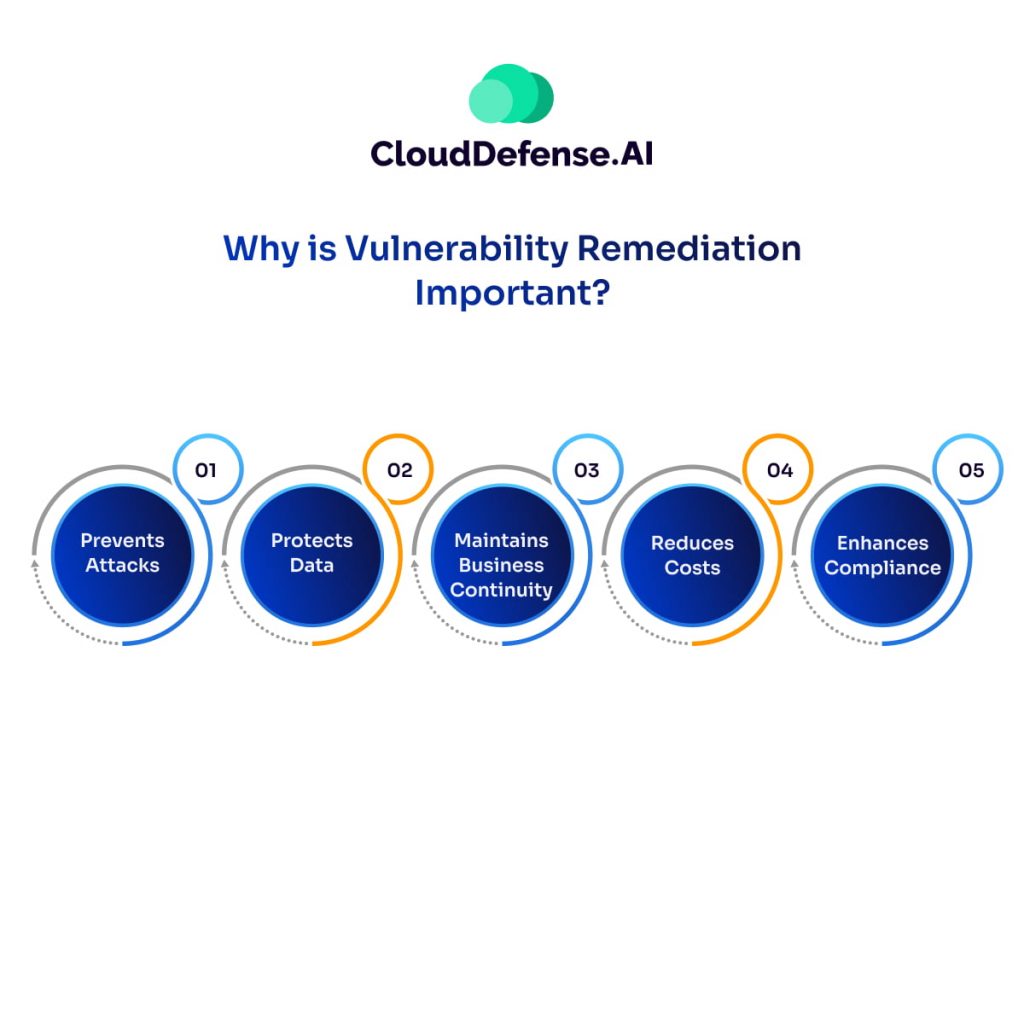
- Prevents Cyber Attacks: Unpatched vulnerabilities are open invitations for cybercriminals. By patching them, you eliminate these entry points and significantly reduce the attack surface.
- Protects Data: Data breaches are often the result of exploited vulnerabilities. Remediation safeguards sensitive information like financial records or intellectual property.
- Maintains Business Continuity: Cyberattacks can disrupt operations and cause downtime. Remediation minimizes the risk of such disruptions, ensuring business continuity.
- Reduces Costs: The cost of a data breach can be enormous. Investing in vulnerability remediation is far more cost-effective than dealing with the aftermath of a successful attack.
- Enhances Compliance: Many regulations mandate organizations to have vulnerability management programs in place. Remediation ensures compliance with these regulations.
| Read More: Are you managing vulnerabilities effectively? Check out our comprehensive article on Vulnerability Management and take control of your security posture! |
How does Vulnerability Remediation Works?
The four steps of vulnerability remediation process form a continuous cycle, ensuring your defenses are constantly identified, evaluated, and improved. There are 4 key steps in the comprehensive remediation process
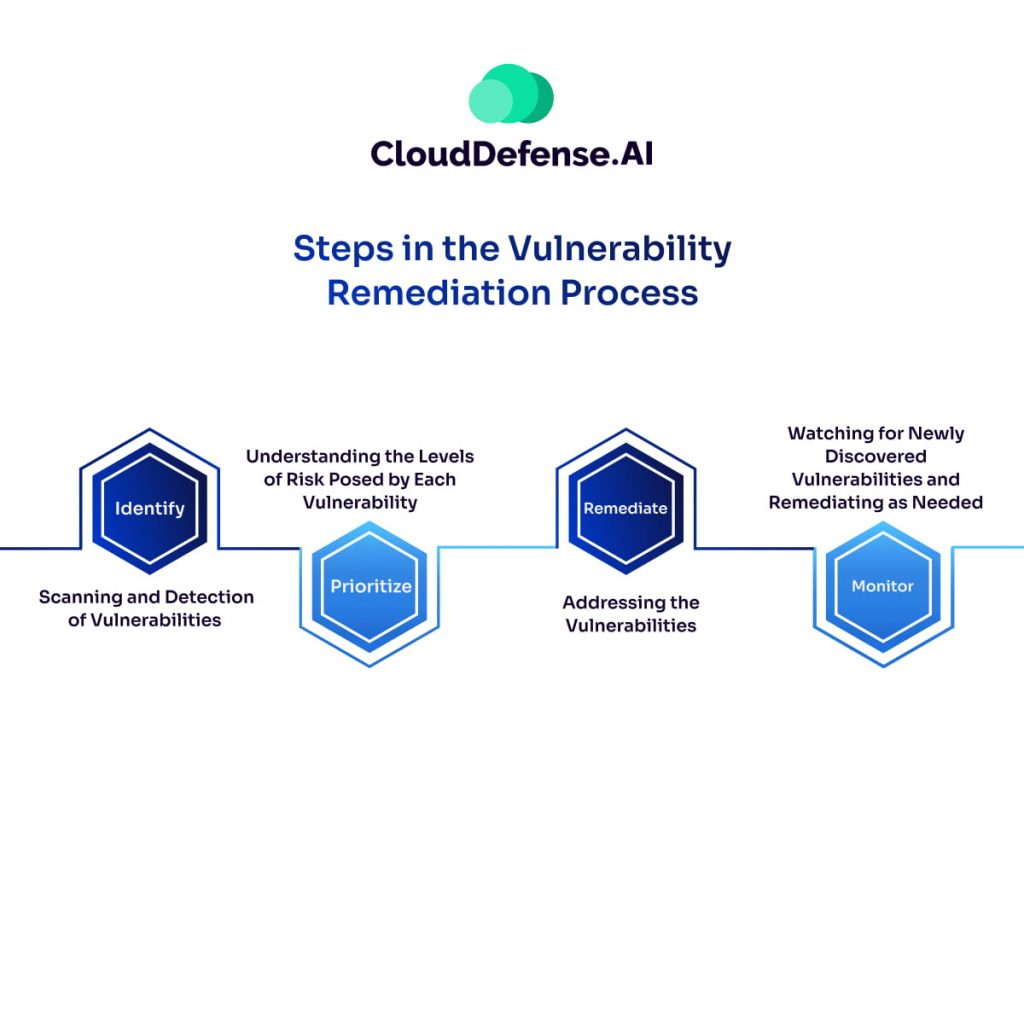
Step 1: Identify — Scanning and Detection of Vulnerabilities
The first step is to identify the chinks in your armor. This involves actively searching for vulnerabilities using various tools and techniques like:
- Vulnerability scanners: Automated tools that scan systems and applications for known vulnerabilities.
- Penetration testing: Simulating a cyberattack to identify exploitable weaknesses.
- Security audits: Comprehensive assessments of your security posture, including vulnerability identification.
Step 2: Prioritize — Understanding the Levels of Risk Posed by Each Vulnerability
Not all vulnerabilities are created equal. Some pose a critical risk, while others may be less severe. Here’s how prioritization is done:
- Exploitability: How easily an attacker can exploit the vulnerability.
- Impact: The potential damage caused by a successful exploit.
- Affected assets: The criticality of the systems or data at risk.
By considering these factors, you can focus your remediation efforts on the vulnerabilities that pose the greatest threat.
Step 3: Remediate — Addressing the Vulnerabilities
Once prioritized, it’s time to plug the holes. Depending on the vulnerability, this may involve:
- Applying security patches: Software updates released by vendors to fix vulnerabilities.
- Implementing configuration changes: Adjusting system settings to mitigate risks.
- Workarounds or temporary fixes: While not ideal long-term solutions, these can buy time until a permanent fix becomes available.
Step 4: Monitor — Watching for Newly Discovered Vulnerabilities and Remediating as Needed
The cybersecurity ecosystem is swiftly diversifying, with new vulnerabilities discovered all the time. Continuous monitoring is essential to stay ahead of the curve. This involves:
- Regular vulnerability scanning: Re-scanning systems and applications to identify newly discovered vulnerabilities.
- Security intelligence feeds: Staying updated on the latest threats and vulnerabilities.
- Patch management systems: Automating the deployment of security patches to ensure timely remediation.
Challenges of Vulnerability Remediation
Organizations encounter several critical challenges when tackling vulnerability remediation. To deal with this complex process effectively, consider the following formula:
Key Questions:
- Identify Priorities:
- Question: Which vulnerabilities should I address first?
- Consideration: Establish a clear understanding of your attack surface to prioritize effectively.
- Optimize Efficiency:
- Question: How can I efficiently remediate those vulnerabilities?
- Consideration: Contextualize your environment, including risk policies and asset importance, to streamline remediation efforts.
- Rank Based on Resources:
- Question: How do I prioritize vulnerabilities based on my resources and business risk tolerance?
- Consideration: Balance vulnerability severity with your organization’s resource availability and risk appetite.
- Set Realistic Timelines:
- Question: How do I set realistic deadlines for my vulnerability remediation plan?
- Consideration: Assess the time and resources required for both scanning and remediation, aligning them with business goals.
Challenges to Address:
- Lack of Clarity: Without a comprehensive understanding of your attack surface, it’s difficult to determine the priority of vulnerabilities.
- Resource Constraints: Limited time, budget, and manpower make efficient remediation challenging.
- Contextual Understanding: Gathering necessary context about risk policies, asset importance, and service level objectives (SLOs) can be tough, especially for overwhelmed IT teams.
- Continuous Management: Remediation should be part of an ongoing threat management strategy that includes continuous vulnerability assessment and remediation, rather than a one-time effort.
To eliminate these challenges, we will discuss best practices in the next section to enhance your vulnerability remediation efforts, helping you build a stronger security posture.
Best Practices to Create a Vulnerability Remediation Plan
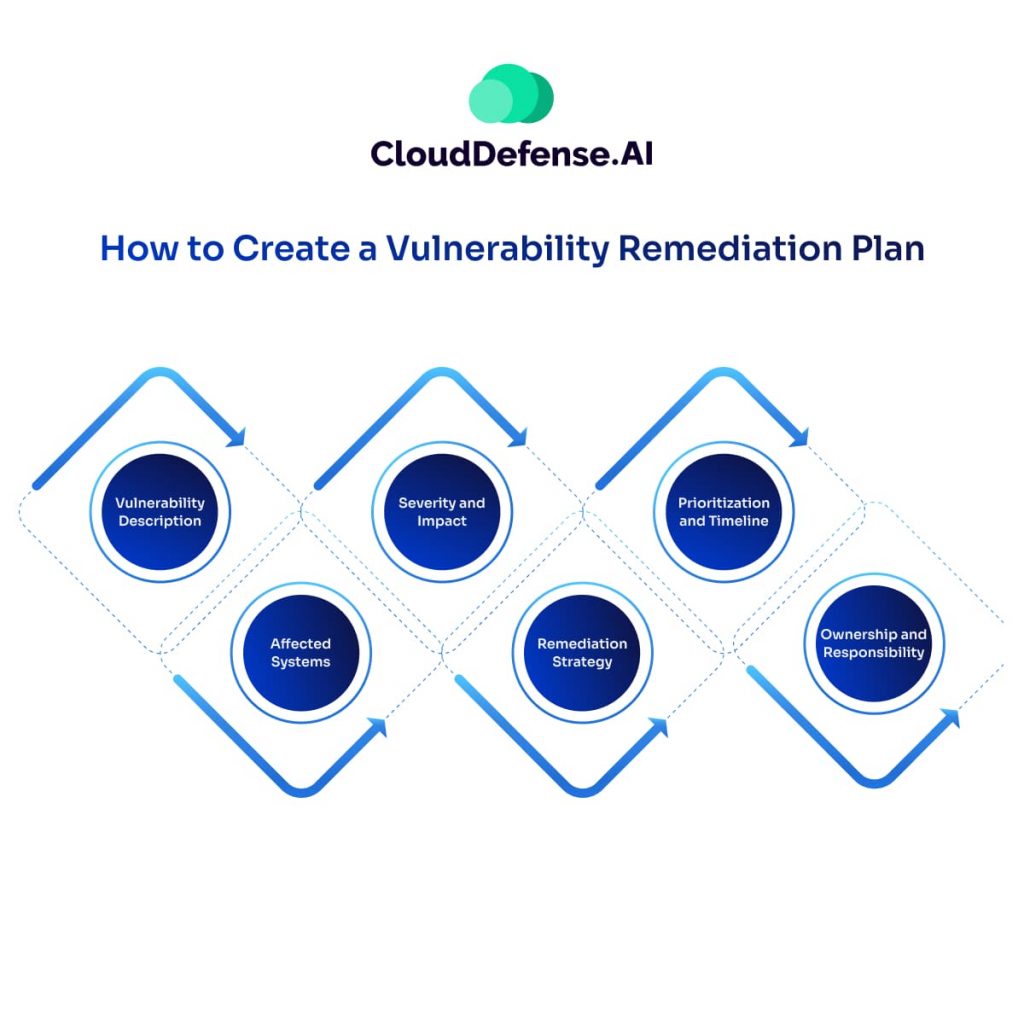
After vulnerability scanning and prioritization, it’s time to translate those findings into action with a well-defined remediation plan. This plan serves as a roadmap, detailing the steps needed to address each prioritized vulnerability.
1. Crafting a Comprehensive Plan:
An effective vulnerability remediation plan should encompass the following:
- Vulnerability Description: A clear explanation of the vulnerability, including its technical details and CVE (Common Vulnerabilities and Exposures) identifier, if applicable.
- Affected Systems: Identification of the specific systems or applications impacted by the vulnerability.
- Severity and Impact: An assessment of the vulnerability’s severity level (critical, high, medium, low) and its potential consequences if exploited.
- Remediation Strategy: The recommended solution to address the vulnerability. This could involve patching the software, implementing a workaround, or isolating affected systems.
- Prioritization and Timeline: Assigning a remediation priority level (urgent, high, medium, low) and setting a realistic timeframe for addressing the vulnerability.
- Ownership and Responsibility: Clearly defining the individual or team responsible for implementing the remediation steps.
2. Assigning Roles and Responsibilities:
A crucial aspect of planning is assigning clear roles and responsibilities for executing the remediation plan. This might involve tasking IT personnel with specific actions or 3. collaborating with vendors to deploy patches or updates.
3. Testing and Monitoring:
Remember, vulnerability remediation isn’t complete until the fix is verified. Testing remediation actions ensures the chosen solution effectively addresses the vulnerability. Furthermore, ongoing monitoring is essential to stay ahead of new threats. By continuously scanning for vulnerabilities and implementing a proactive remediation strategy, organizations can significantly enhance their overall cybersecurity posture.
How Can Businesses Prioritize Identified Vulnerabilities?
Now, once you get a long list of identified vulnerabilities, it can be overwhelming to decide which ones to tackle first. Here’s how businesses can effectively prioritize these threats:
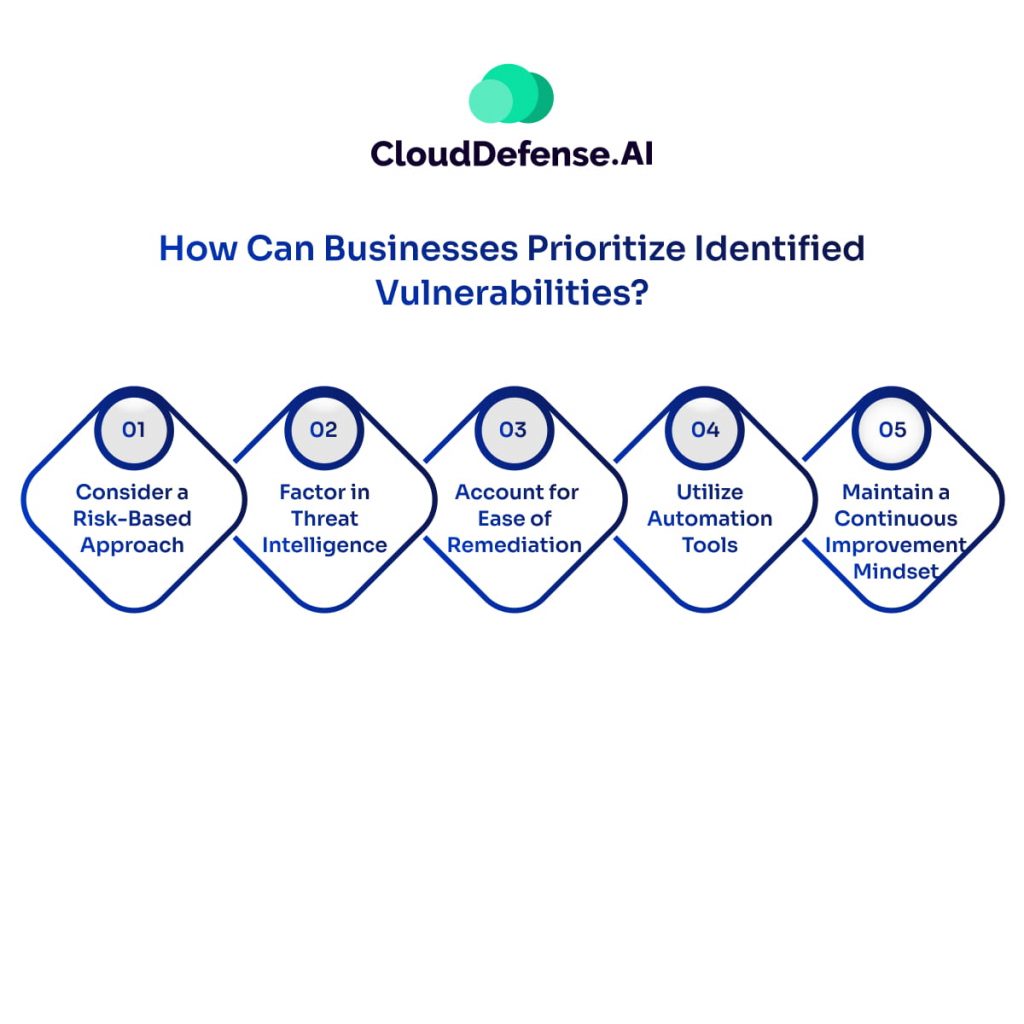
1. Consider a Risk-Based Approach:
- CVSS (Common Vulnerability Scoring System): This industry-standard scoring system assigns a severity score (0-10) based on exploitability, potential impact, and other factors. While CVSS is a valuable tool, it shouldn’t be the sole factor.
- Exploitability: Evaluate how easily an attacker can exploit the vulnerability. Is public exploit code available? Are there specific attacker tools known to target this weakness?
- Impact: Analyze the potential consequences of a successful exploit. Consider factors like data loss, financial repercussions, reputational damage, and operational disruption.
- Business Context: Not all assets are created equal. Prioritize vulnerabilities that affect critical systems, sensitive data, or revenue-generating applications.
2. Factor in Threat Intelligence:
- Stay updated on current threat trends and attacker behaviors. Are there recent attacks targeting similar vulnerabilities?
- Leverage threat intelligence feeds to gain insights into the latest exploits and attacker motivations.
3. Account for Ease of Remediation:
- Sometimes, patching a vulnerability can be complex or require system downtime. Balance the severity of the risk with the feasibility of applying a fix. In some cases, a temporary workaround might be implemented until a permanent solution becomes available.
4. Utilize Automation Tools:
- Vulnerability management tools can automate tasks like scanning, scoring, and prioritizing vulnerabilities based on pre-defined criteria. These tools can streamline the process and free up security teams for more strategic tasks.
5. Maintain a Continuous Improvement Mindset:
- The vulnerability issues of your digital infrastructure is constantly evolving. So, regularly review your prioritization criteria and update your plan as needed.
- Conduct vulnerability scanning at regular intervals to identify new threats and ensure existing remediations remain effective.
By following these steps, businesses can prioritize vulnerabilities effectively, focusing on the ones that pose the greatest risk and ensuring their cybersecurity posture remains strong.
Automated Vulnerability Remediation
Even the most well-resourced security teams can be overwhelmed by the ever-growing threat front and the sheer volume of vulnerabilities discovered. This is where automated vulnerability remediation comes in. It utilizes technology to streamline and expedite the remediation process, freeing up security personnel to focus on more strategic tasks.
Here are some key aspects of automated vulnerability remediation:
1. Faster Response Times: Automation can significantly speed up the remediation process. Repetitive tasks like vulnerability scanning, prioritization, and even patch deployment can be automated, freeing up security teams to focus on complex issues and strategic initiatives.
2. Improved Accuracy: Manual processes are prone to human error. Automation eliminates this risk, ensuring consistent and accurate vulnerability identification and prioritization.
3. Reduced Costs: By automating repetitive tasks, organizations can save time and resources associated with manual remediation efforts. This allows them to invest in other security measures or expand their security team’s capabilities.
4. Scalability: Automation tools can handle large volumes of data and assets efficiently. This is particularly beneficial for organizations with extensive IT infrastructure or complex security environments.
5. 24/7 Remediation: Automation can perform remediation tasks around the clock, even outside regular business hours. This ensures vulnerabilities are addressed promptly, minimizing the window of opportunity for attackers.
So, what can be Automated?
Several aspects of vulnerability remediation can be automated, including:
- Vulnerability Scanning: Automated tools can routinely scan systems and applications for known vulnerabilities, ensuring ongoing awareness of potential threats.
- Vulnerability Prioritization: Automation can prioritize vulnerabilities based on predefined criteria, such as CVSS score, exploitability, and business context, allowing organizations to focus on the most pressing issues first.
- Patch Deployment: Automated patch management systems can efficiently deploy security patches to vulnerable systems, ensuring timely remediation and reducing the risk of exploitation.
- Configuration Management: Automated configuration management tools can enforce desired security settings, effectively mitigating vulnerabilities that arise from misconfigurations.
Partnering with CloudDefense.AI: AI-based Automated Remediation at Your Fingertips
We totally get that dealing with vulnerabilities can feel like a never-ending struggle, but you don’t have to go it alone. With CloudDefense.AI’s auto remediation feature, you gain access to intelligent automation that not only streamlines vulnerability remediation but also strengthens your overall cloud security posture.
One-Click Remediation with AI
What if you’re having the power to resolve vulnerabilities with just a single click. That’s what our advanced AI engine offers. It swiftly identifies and addresses threats in your cloud and application infrastructure, drastically cutting down your exposure time.
We make the remediation process straightforward by providing step-by-step guidance, so you can focus on what really matters—growing your business—while still keeping security tight.
Smart Threat Detection and Instant Response
At CloudDefense.AI, we don’t wait for threats to become critical. Our intelligent system proactively scans your environment, catching vulnerabilities as soon as they arise. You’ll receive instant recommendations and actionable solutions, allowing you to tackle risks head-on and prevent potential breaches before they can impact your organization.
Comprehensive Coverage and Prioritization
Our tailored auto-remediation goes beyond point solutions. We cover the critical components of your Cloud Security Stack, including Cloud Security Posture Management (CSPM), Cloud Infrastructure Entitlement Management (CIEM), and workload security, ensuring comprehensive protection across your entire cloud environment.
Plus, our system prioritizes vulnerabilities based on severity, enabling you to allocate your resources effectively and tackle the most critical threats first.
Step-by-Step Remediation Guides
We believe in going the extra mile for our partners. CloudDefense.AI not only identifies and prioritizes vulnerabilities but also empowers you to resolve them efficiently. Our user-friendly, step-by-step guides walk you through the remediation process for each identified threat. With clear instructions and expert insights, you can confidently address vulnerabilities and maintain a secure cloud environment.
Ready to Experience How we Streamline Automated Remediation? Don’t wait – take control of your cloud security today. Book a free demo and witness how CloudDefense.AI can drastically improve your vulnerability remediation process. See how our intelligent automation can streamline your security operations, reduce risks, and free up valuable resources for your team.


